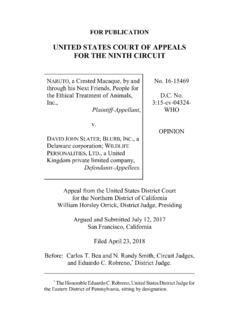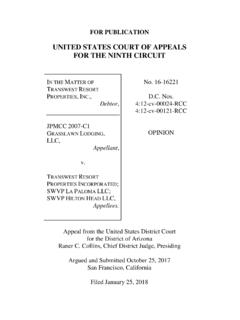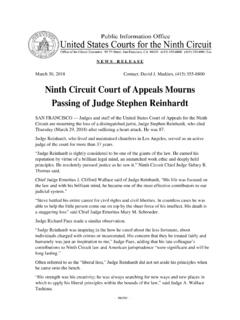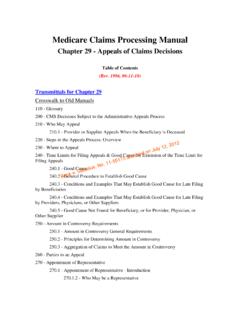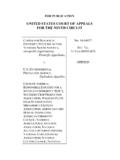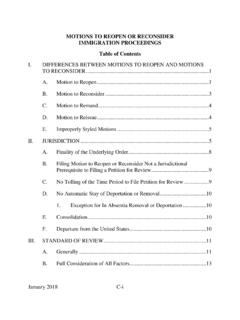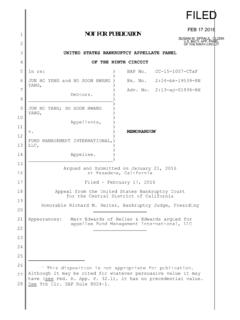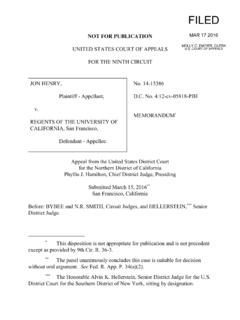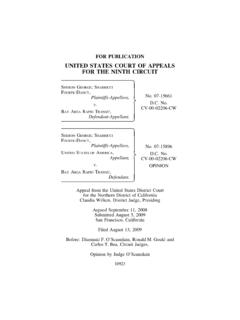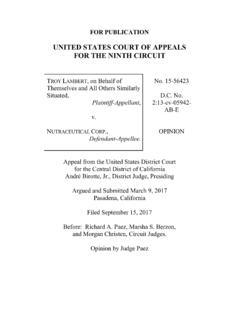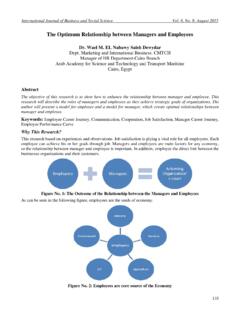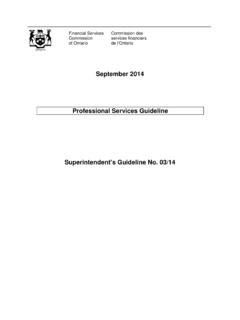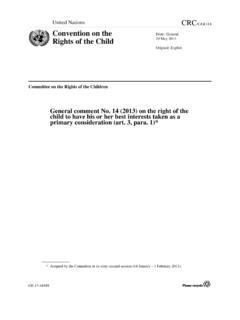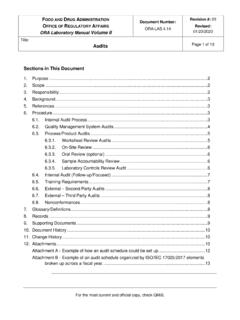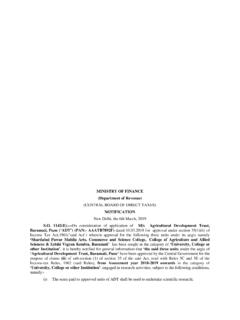Transcription of UNITED STATES COURT OF APPEALS FOR THE NINTH CIRCUIT
1 FOR PUBLICATION. UNITED STATES COURT OF APPEALS . FOR THE NINTH CIRCUIT . LUIS ENRIQUE SANCHEZ, AKA No. 14-71768. Enrique Cruz Sanchez, AKA Luis Llamas Sanchez, AKA Luis Charles Agency No. Sanchez, AKA Enrique Sanchez A076-359-028. Cruz, AKA Luis Enrique Sanchez Llamas, Petitioner, ORDER. v. WILLIAM P. BARR, Attorney General, Respondent. Filed April 1, 2019. Before: Kim McLane Wardlaw, Richard A. Paez, and Morgan Christen, CIRCUIT Judges. Order;. Concurrence in Order by Judge Paez;. Statement Respecting Order by Judge O'Scannlain;. 2 SANCHEZ V. BARR. SUMMARY *. Immigration The panel filed an order denying rehearing en banc in a case in which the panel held that Luis Sanchez may be entitled to termination of removal proceedings without prejudice as the result of having made a prima facie showing of an egregious violation of 8 (b)(2) (to detain a person for questioning, an immigration officer must have reasonable suspicion the person is, or is attempting to be, engaged in an offense against the UNITED STATES , or is an alien illegally in the country), and remanded for the agency to afford the Government an opportunity to rebut Sanchez's prima facie case.
2 Concurring in the denial of rehearing en banc, Judge Paez, joined by Judge Wardlaw, wrote to reiterate points in response to Judge O'Scannlain's separate statement. Judge Paez wrote that Judge O'Scannlain's statement attempted to obscure the core issue the egregious regulatory violation . with the smokescreen of the exclusionary rule, and wrote that Judge O'Scannlain's opinion rested on a mischaracterization of decades of precedent. Judge Paez wrote that, contrary to Judge O'Scannlain's assertions, the panel did not pull the remedy of termination with prejudice out of thin air; rather, the remedy was based on this COURT 's precedent and consistent with the Supreme COURT 's long-standing concern for regulatory violations that implicate fundamental rights. Responding to Judge *. This summary constitutes no part of the opinion of the COURT .
3 It has been prepared by COURT staff for the convenience of the reader. SANCHEZ V. BARR 3. O'Scannlain's insistence that the COURT has no authority to address an egregious violation of this regulation, Judge Paez wrote that the regulation implicates constitutional rights, thereby triggering the COURT 's duty to ensure agency compliance. Judge Paez also responded to Judge O'Scannlain's opinion that the remedy would do nothing but delay Sanchez's inevitable removal, stating that this view misses the essence of Sanchez's claim and the harm he sought to remedy. In this regard, Judge Paez wrote that more was at stake than the outcome of a single case in that the remedy recognized the tainted nature of the initial detention and, one hopes, would encourage agency compliance. Finally, Judge Paez wrote that Judge O'Scannlain's parade of horribles regarding the consequences of the panel's remedy were unsubstantiated and, at best, hypothetical.
4 Respecting the denial of rehearing en banc, Judge O'Scannlain, joined by Judges Callahan, Bea, Ikuta, Bennett, and R. Nelson, wrote that the COURT should have reheard this case en banc to correct the panel's errant decision, a very unfortunate precedent with troublesome consequences for the COURT 's immigration jurisprudence. Judge O'Scannlain observed that the government in this case possessed independent and (constitutionally firm) evidence establishing Sanchez's unlawful status, and, as a result, suppression of the evidence obtained by the arrest would do Sanchez no good. Judge O'Scannlain wrote that, eager to give Sanchez some relief, the panel stretched this COURT 's case law beyond recognition by awarding termination without prejudice instead of an appropriate Fourth Amendment remedy suppression of the unlawfully obtained evidence.
5 Judge O'Scannlain wrote that the panel's decision (1) defied the Supreme COURT 's decision in INS v. Lopez- 4 SANCHEZ V. BARR. Mendoza, 468 1032 (1984), (2) ignored basic Fourth Amendment principles by ordering a more-intrusive result than the Amendment authorizes, (3) fashioned a remedy to enforce agency regulations without a sound legal basis for such an imposition, (4) showed a profound misunderstanding of the difference between substantive and procedural rights and their appropriate remedies, (5) cited as authority a handful of inapposite out-of- CIRCUIT precedents, and (6) imposed serious practical costs on the administration of immigration proceedings. Judge O'Scannlain concluded that, worst of all, the opinion's imposition of an extraordinary remedy wastes everyone's time, for it does nothing but delay the petitioner's inevitable removal.
6 ORDER. A judge of the COURT sua sponte requested a vote on whether to rehear this case en banc. A vote was taken, and the matter failed to receive a majority of the votes of the nonrecused active judges in favor of en banc consideration. See Fed. R. App. P. 35(f). Rehearing en banc is DENIED. PAEZ, CIRCUIT Judge, with whom WARDLAW, CIRCUIT Judge joins, concurring in denial of rehearing en banc: This case began when the UNITED STATES Coast Guard seized Luis Sanchez solely on the basis of his race. The critical question before the panel was what, if any, remedy existed for Sanchez. We thus confronted a clear case of racial profiling an egregious violation of the Department of Homeland Security's own internal regulation to deter unlawful searches and seizures, 8 (b)(2). In SANCHEZ V. BARR 5. line with the Second CIRCUIT , we held that an egregious violation of (b)(2) could warrant termination of removal proceedings without prejudice and we remanded to the agency to afford the Government an opportunity to rebut Sanchez's prima facie case.
7 Sanchez v. Sessions, 904 643, 653 54 (9th Cir. 2018) (citing Rajah v. Mukasey, 544 427, 446 47 (2d Cir. 2008)). Nothing more, nothing less. This limited but tailored remedy ensures that immigration officers are held accountable for violating rules that are meant to safeguard individuals' fundamental rights. INS v. Lopez-Mendoza, 468 1032, 1044 (1984). Even the Government agreed that remand, not rehearing en banc, was the appropriate next step for Sanchez's case. Judge O'Scannlain's separate statement attempts to obscure the core issue the egregious regulatory violation . with the smokescreen of the exclusionary rule. 1 His quarrel with our opinion, however, rests on a mischaracterization of decades of precedent that this COURT has wisely sidestepped. I therefore concur in the COURT 's denial of rehearing en banc and respectfully but firmly reiterate a few points in response to errors in Judge O'Scannlain's statement.
8 1. Judge O'Scannlain's reliance on Lopez-Mendoza is particularly telling as it illustrates a misunderstanding of the case law. In holding that the Fourth Amendment does not generally apply to civil immigration proceedings, the Supreme COURT relied in part on the fact that the agency has developed rules restricting stop, interrogation, and arrest practices.. 468 at 1044 45. Moreover, the COURT stated that it was not addressing a regulatory violation because no challenge [wa]s raised here to the [agency]'s own internal regulations. Id. at 1050. Thus, Lopez-Mendoza explicitly left open the question of how courts should address regulatory violations in this context. 6 SANCHEZ V. BARR. **. As a preliminary matter, there is no dispute that Sanchez made a prima facie showing of a violation of (b)(2): he was detained solely on the basis of his Latino appearance and hence, without reasonable suspicion, as required by the regulation.
9 2 As detailed in our opinion, the Coast Guard detained Sanchez and his three companions, including a 14- month-old child, after they called 911 for assistance when they were stranded on a fishing trip from Channel Islands Harbor. Without reasonable suspicion, the Coast Guard contacted Customs and Border Protection to report the possibility of 4 undocumented worker[] aliens, which ultimately led to Sanchez's arrest, interrogation and removal proceedings. Looking to past cases involving regulatory violations, we joined the Second CIRCUIT to hold that petitioners like Sanchez may be entitled to termination of their removal proceedings without prejudice for egregious regulatory violations. 3 Sanchez, 904 at 653 (citing 2. The regulation provides: [i]f the immigration officer has a reasonable suspicion, based on specific articulable facts, that the person being questioned is, or is attempting to be, engaged in an offense against the UNITED STATES or is an alien illegally in the UNITED STATES , the immigration officer may briefly detain the person for questioning.)
10 8 (b)(2). 3. Judge O'Scannlain's attempt to sidestep the holding of Rajah is unconvincing. The plain language of Rajah identifies termination as an appropriate remedy for pre-hearing, conscience-shocking regulatory violations. 544 at 447. Rajah therefore expressly allows for termination in Sanchez's case because racial profiling is conscience- shocking and egregious. Sanchez, 904 at 656 (citing, inter alia, City of Richmond v. Croson Co., 488 469, 521 (1989) (Scalia, J., concurring)). Moreover, subsequent cases in the Second CIRCUIT have faithfully applied the Rajah framework. Maldonado v. Holder, 763 155, 163 (2d Cir. 2014). The fact that the Second CIRCUIT has identified SANCHEZ V. BARR 7. UNITED STATES v. Calderon-Medina, 591 529 (9th Cir. 1979); Rajah, 544 at 446 47). Contrary to Judge O'Scannlain's assertions, we did not pull such a remedy out of thin air.
